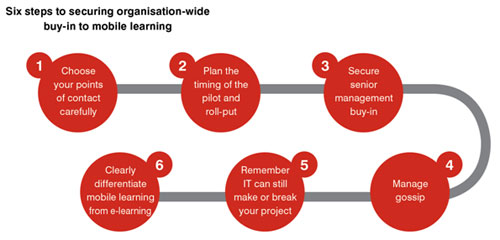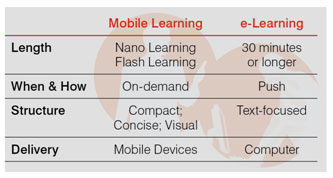Gerry Griffin of Skill-Pill M-Learning looks at who's helping, who's resisting and why.

Sidebar 1- Six steps to securing organisation-wide buy-in to mobile learning
1. Choose your points of contact carefully
2. Plan the timing of the pilot and roll-put
3. Secure senior management buy-in
4. Manage gossip
5. Remember IT can still make or break your project
6. Clearly differentiate mobile learning from elearning
Introducing the concept of mobile learning into an organisation can easily get a negative reaction. After all, elearning has been a buzzword for over a decade, and many organisations want to see a good return on their investment before they even consider new approaches.
Clearly, mobile learning needs to differentiate itself from elearning but there are lots of side battles that also need to be won. Implementing a mobile learning strategy involves many departments. Let's not think the worst of people but it is important to understand the mindset of potential blockers.
For example, IT will need evidence of senior executive commitment and a sound business case before they commit resources for data transfer and data storage of mobile content. So will procurement if they will need to unbundle hard-fought-for deals on mobile phone plans to increase or add mobile data allowances. That is even before you get into discussions allowing employees to browse the internet on their work mobiles or integrating third-party technology/apps into the corporate learning management systems. Corporate communications and brand may have something to say about the style of content going onto mobiles, and might wish to impose some tight guidelines.
 "Implementing a mobile learning strategy involves many departments... it is important to understand the mindset of potential blockers."
"Implementing a mobile learning strategy involves many departments... it is important to understand the mindset of potential blockers."And of course yet another learning channel can sound just like more work that hasn't been budgeted for and resourced.
Each of these blockers can be addressed directly or indirectly if you can secure the right kind of buy-in from an organisation. To do so, you need to focus on five key areas:
- Choose your points of contact within the organisation carefully. And focus the introduction of mobile learning on functions with high impact on the business and critical needs in terms of real-time communication. Sales is a good entry point, for example. Identify people comfortable with new technology to be potential champions
- Plan the timing of the pilot and the rollout carefully - involve all departments affected in the planning to ensure there is committed capacity to support the rollout and avoid clashes with major change, sales and marketing programmes
- Secure senior management support – a sound business case that identifies the best opportunities for mobile learning will convince senior decision-makers and will certainly be improved by their endorsement
But remember not to forget the little people too; the ones that want to get involved, have strong opinions and have lots to say. These people can have a role in developing content and convincing others to try mobile learning.
- Manage the gossip – mobile learning is heavily associated with technology and the latest gadgets. And technology is heavily associated with overpromising and letting people down. Once a pilot and a rollout are in progress, support them with clear, consistent, and proactive communication
- Remember IT can still make or break your project. They can be your best friend or worst enemy. So involve them as early as possible, and go as senior as possible. Insist on a pilot project to test the content and delivery systems on. Your business case should enable you to position mobile learning as an exciting opportunity for the organisation
But addressing these areas still leaves mobile learning vulnerable to the easiest of misconceptions. When people hear the words 'mobile learning' it is common for them to think automatically of 'elearning', just on the go. I recently saw a major learning content provider promoting its content as 'on the go' by featuring a person sitting outside their building with a laptop. They may as well have had someone pushing a desktop PC around in a shopping trolley: hey look at me – I'm mobile!
Mobile learning should not just be characterised by mobility. Mobile learning is a step change in the way people learn. It places the power to consume content in the hands of the individual and assumes an organisation trusts their employees to self-diagnose their learning needs and have the capacity to find content to fulfil those needs. This is perhaps the biggest cultural blocker of them all. It is about moving beyond the 'campus style' of learning to a more 'street view' style of acquiring knowledge, skills, attitudes, and behaviours at a time and place of the learners choosing and in the format that integrates with their work.
The traditional campus style separates us from the workplace for extended periods of time (hours, days and even weeks) to learn complex, detailed structures; weeks or months before we will have to use the learning. That approach is based upon the three pillars of:
- Understanding the material
- Remembering the material in detail for long periods of time, and
- Applying the material whenever the right opportunity presents itself, even if that means waiting for 'The Opportunity' or 'The Event'.
Most elearning still adopts the 'campus style' approach to learning. It is structured for the learner to 'follow', or attend and to 'store' the knowledge.
Mobile learning is constructed upon a completely different view of the world - the 'street view' approach to learning. With the advent of Google, we have experienced a massive change in the way people view and process information. Technology has made the availability of information widespread, quick and easy to access, and simple to process. We have to remember less long-term and be quick in understanding new ideas. We no longer want to pre-plan and wait for learning opportunities. We don't want to wade through hours of past learning to find the three key things we need to know now. This means that from the inception of the learning, at the design and development stage, mobile learning differs significantly from elearning.
Firstly, it differs in length. Mobile learning is centred around short and sharp learning objectives structured as 'nano' or 'flash learning' - meaning no longer than two minutes in length.
Secondly, it differs in when and how it is used. Learners want specific top-of-mind and refresher learning on-demand minutes or even seconds before they will need to use it. This allows users to integrate the content with work – learning immediately before 'The Event', to apply the advice e.g. running a staff meeting, engaging in a difficult conversation, or remembering the four key safety steps. This is different than having a 30-minute video, or an online course that conveys more information. Just because the material is elearning and online (and therefore on-demand) does not mean it is structured so the learner can use the material like they need to.
Thirdly, mobile learning differs in its structure. Learning content needs to be compact and concise, so it can be used immediately before it is needed. And that requires very sharp and crisp learning objectives, with the use of visual reinforcement images to anchor the learning. Elearning often focuses on more words, more time, more examples; mobile learning focuses on a style of learning that has to fully engage the learner (with words, images, pace) for a short period of time. The content needs to be characterized not by the subject (e.g. leadership and change) but by the challenge, such as merging conflicting teams. This drives up usage and increases productivity.
And finally, mobile learning differs in its delivery; mobile devices today like the iPhone/iPod/iPad, BlackBerry and most mobile phones allow a mobile learning form of delivery. At the same time, mobile learning can be delivered by less mobile devices like a desktop or a laptop. Most elearning today does not work well with mobile devices outside of computers. There are too many words, too much 'talk', too little engagement, and it is simply too hard to watch 30 minutes of video on a phone.
Where elearning has its place within an organisation is in delivering widespread, affordable, computer device-enabled learning. Mobile learning has a difference place; providing integrated, on-demand, everywhere-available, event-oriented learning, critical to enhancing the productivity, content retention and compliance of employees.

Mobile learning is not better than elearning but complementary. Elearning might be an overarching term but it would be a mistake to confuse mobile learning and the specific advantages we gain from implementing mobile learning projects, with the reasons we employ elearning. Elearning has helped us deliver training across the organization. Mobile learning helps us take learning to people and helps us truly make learning for people.
Gerry Griffin is director of Skill-Pill M-Learning and a former director of the London Business School and author of six business books. A frequent TV commentator on web developments, he has lectured in the U.S., Europe, Asia, and Africa. Gerry founded Skill-Pill in 2006, and is passionate about the impact m-learning can have in supporting executives in the workplace.










